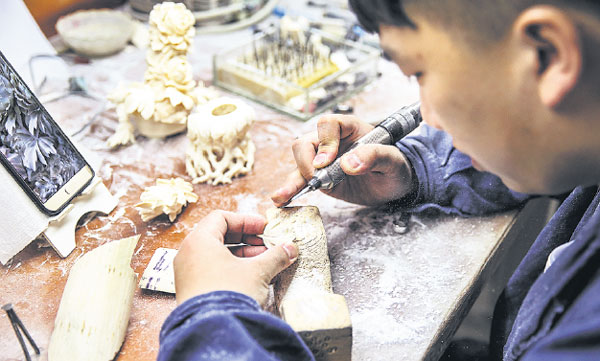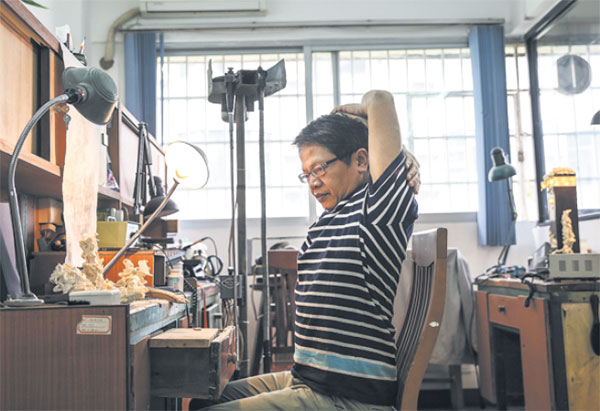Carvers make a lifetime's commitment to their art
Walking down an alley off a bustling street in Chongwenmen, downtown Beijing, it's easy to miss a sign next to a small glass door that announces the Beijing Ivory Carving Factory, so very few people enter the simple facade.
A workshop housing about a dozen craftsmen is located just to the left of the entrance. Noise and white ivory dust fill the air every time the cutting machine is in operation.
Removing a thick, protective mask, Guo Chen, 29, revealed his face. In 2009, the graduate of the College of Art and Design at Beijing University of Technology was one of seven graduates recruited by the factory, the first time the carving workshop had seen new faces in two decades. Prior to the recruitment, the youngest craftsman was 54.
In 2015, two more graduates from the same college were recruited, but they are likely to be the last.
|
Guo Chen carves a piece of ivory at his desk at the Beijing Ivory Carving Factory. |
|
A member of staff at work at the Guangzhou Daxin Ivory Carving Factory. |
"The time-hallowed crafts are disappearing. If the younger generation doesn't pass the skills on, they will die out soon," said Zhang Shulan, director of the factory's art and design department.
Unlike carving on lower-grade materials, working with ivory is a painstaking business because of the high cost of the materials. Before they begin carving on small pieces of leftover ivory, novices have to practice on wood for six months to a year.
Based on their talent and personal interests, each student has a mentor who specializes in a certain skill. After studying for three years, a beginner becomes a fully fledged apprentice, the lowest rung of the ladder.
A new field
It's now eight years since Guo started learning to carve ivory, and he is focusing on flowers. As a sculpture major in college, he said ivory carving is a new field, but it retains the core ideal of "removing" rather than "adding" .
Thanks to his studies at college, Guo is familiar with both Eastern and Western art, and the clash of cultures often provides him with fresh inspiration. Unlike traditional works, which often feature flowers, rocks and landscapes, he tries to add animals as a new element to the natural scenery.
"I feel good focusing on just one thing for months, or even years. Craftsmanship, or what people usually describe as the artisan spirit, is precious in today's fast-paced world," he said. "Even children can tell if your carving is lifelike or not."
Guo and his wife, who was a classmate at college, both work at the factory as carvers. Their combined monthly salary is just 10,000 yuan ($1,450), which means they are unable to afford even a small apartment outside the Fifth Ring Road, far from the center of Beijing.
However, the low income is of less concern to Guo than a national ban on the ivory trade that will come into force at the end of the year. "My worry is not about losing my job. I am still young enough to start a new career, but our craftsmanship has no chance of surviving," he said.
"In many jobs, eight years seems a long time, but in ivory carving, it's just the start. All seven of us have stuck with this career for nearly a decade and we really want to gain a deeper understanding of these skills, which are now on the verge of extinction."
Guo isn't the only craftsman who feels helpless in the face of the forthcoming national ban on ivory trading.
"Leaving aside the question of the future, if no policy is devised to save this dying art, it may be impossible to repair ancient art works in a few decades," said Geng Boling, who has practiced ivory carving for 46 years, and has worked as a repairer of artifacts at the Palace Museum in Beijing since 2014.
In the past three years, Geng has repaired ivory pieces from the Ming (1368-1644) and Qing dynasties (1644-1911). "That's the highest level of artistic achievement - the acme of perfection," he said.
However, a lack of elephant tusks and the loss of a number of traditional skills means the repair of large artifacts has been suspended indefinitely. Every time he looks at masterpieces made hundreds of years ago, Geng envies the old masters who devoted their entire lives to the craft.
"Life is not a fairy tale where all dreams come true," he said. At 63, he is no longer concerned about whether his skills will feed his family, so he has chosen to accept that ivory carving is doomed.
"For the development of society, it's just one of thousands of ways of earning a living and is relevant to very few people," he said. While he agrees that elephants should be protected, Geng doesn't want to see all ivory outlawed.
Exploitation and extinction
"Overexploitation of ivory will result in elephants becoming extinct, but artists should be allowed to use ivory from elephants who have died of natural causes, and pass their skills and experience onto the next generation," he said.
Even if the use of ivory were outlawed completely, the artisans could still work with jade, wood, bull's bones and even mammoth tusks, but few would make the choice.
Zhang, the factory director, said ivory has perfect hardness, somewhere between wood and jade, which makes almost all shapes, such as tiny petals and leaves possible. It can even be fashioned into stripes as thin as instrument strings.
The best illustration of ivory's unique nature is a sleeping mat used by the Empress Dowager Cixi of the Qing Dynasty, which was woven from very thin, soft strips of ivory and is as flexible as wicker, according to Zhang.
Other materials, such as bull's bones have limitations in terms of size and shape, so they can only be used for small, simple works.
"Mammoth ivory, the only legal material with a texture similar to elephant ivory, is the best choice. But it's no cheaper, and the amount available is very limited," she said.
Now, only 35 artisans work at the Guangzhou Daxin Ivory Carving Factory in Guangdong province - China's only State-owned ivory facility - but in the 1960s, about 600 people were employed in the company's workshops.
The factory's name, Daxin, is also the name of a street in the center of Guangzhou, Guangdong province, which was famous as the epicenter of the ivory trade during the Qing Dynasty.
Founded in 1955, the factory once had three shops in the street. Years ago, it moved to an old three-story building in a suburb. Many of the carvers left - some moved into other industries, while the rest learned to work with bone or wood, which were far less lucrative trades.
Zhang Minhui, who joined Daxin in 1972 at age 19, is one of the few carvers who enjoyed success after leaving the factory. He now runs his own workshop called the Flower City Boya Craftwork Factory.
Honored as a Guangdong ivory carving master and a National Inheritor of Intangible Cultural Heritage, Zhang Minhui is not only an active artist, he is also passionate about social activities. About 15 titles are printed on his name card, including chairman of the Guangzhou Folk Artists Association and deputy director of the Guangdong Arts and Crafts Association.
His workshop employs about 20 artisans, who work with ivory, bull's bones and mammoth tusks. He only keeps a small stock of ivory, so when that is exhausted, his employees will mainly work with other materials.
"It's not the best option, but it's better than no option. Most experienced craftsmen are age 60 or older and they aren't concerned about losing their jobs. However, the real concern is the fate of ivory carving as an art. It would be a sad loss," he said.
(China Daily USA 05/22/2017 page9)



 Print
Print Mail
Mail



